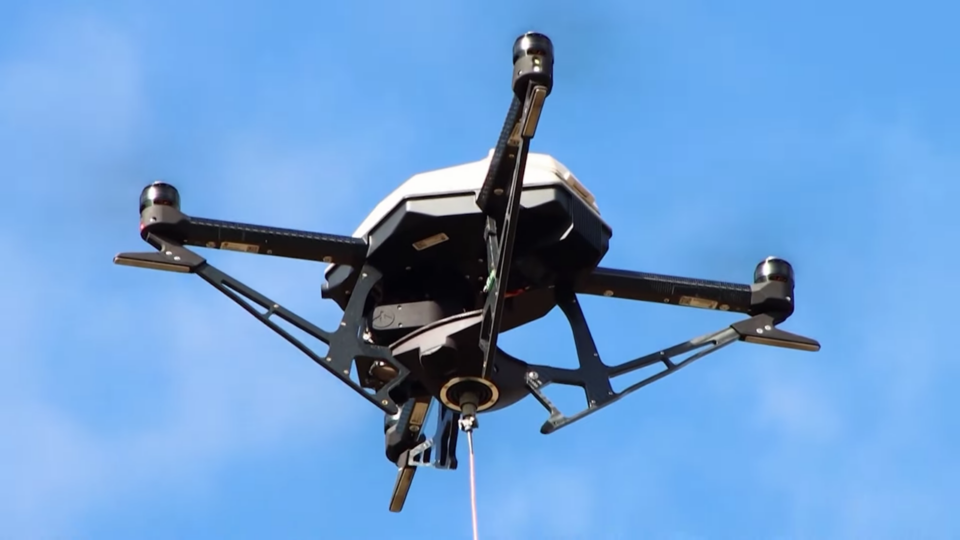In the vast expanse of the sky, where freedom and innovation converge, drones have emerged as a transformative force. These unmanned aerial vehicles (UAVs) have transcended their initial military applications to become indispensable tools across various industries, from agriculture to cinematography. Yet, even as drones have soared to new heights, challenges such as limited flight time and data connectivity persist. Linden Photonics drone tether technology—an innovative solution poised to revolutionize the way we perceive and utilize drones.
At its core, drone tethering involves securing a UAV to the ground via a physical tether, typically a lightweight cable. This tether serves a dual purpose: it provides power to the drone and establishes a continuous data link, overcoming the limitations of battery life and wireless connectivity. The result is a paradigm shift in drone operations, unlocking new possibilities for extended flight durations, real-time data transmission, and enhanced operational reliability.
One of the most significant advantages of drone tethering is the extension of flight time. Conventional drones are often constrained by their battery capacity, limiting their airborne duration to mere minutes or, at most, a few hours. This constraint severely hampers applications that require sustained aerial monitoring or surveillance, such as security patrols or disaster response. By tethering a drone, however, power becomes a non-issue. The continuous supply from the tether enables drones to stay aloft for extended periods, ranging from hours to days, depending on the power source and configuration.
Moreover, the tether serves as a reliable conduit for data transfer. Unlike wireless communication, which can be susceptible to interference and range limitations, tethered drones maintain a robust and consistent data link throughout their operation. This direct connection ensures seamless transmission of video feeds, sensor data, and control signals, making tethered drones ideal for critical missions where real-time information is paramount.
The applications of Linden Photonics drone tether technology span a diverse spectrum of industries and use cases. In the realm of public safety and law enforcement, tethered drones provide persistent aerial surveillance capabilities, aiding in search and rescue operations, monitoring crowd activities, and enhancing situational awareness during emergencies. Similarly, in the agricultural sector, tethered drones facilitate precise and continuous monitoring of crops, livestock, and environmental conditions, enabling farmers to make data-driven decisions and optimize resource allocation.
The entertainment and media industry also benefits significantly from drone tethering. Film productions leverage tethered drones for stable aerial cinematography, capturing breathtaking shots with extended flight durations and precise maneuverability. Live events, too, harness the power of tethered drones for immersive aerial coverage without interruptions or signal loss.
Furthermore, drone tether technology plays a vital role in infrastructure inspections, remote inspections, and disaster response. Engineers and inspectors utilize tethered drones to access hard-to-reach areas, conduct thorough inspections, and assess structural integrity in real time. During disaster scenarios, such as earthquakes or wildfires, tethered drones provide continuous aerial monitoring, aiding emergency responders in assessing damage, coordinating rescue efforts, and mitigating risks.
The evolution of drone tether technology is fueled by ongoing advancements in materials, power systems, and communication technologies. Lightweight and durable tether cables, coupled with efficient power management solutions, contribute to the portability and reliability of tethered drone systems. Integration with smart sensors, artificial intelligence, and edge computing further enhances the capabilities of tethered drones, enabling autonomous operations, adaptive flight paths, and intelligent data analysis.
Despite its myriad benefits, drone tethering also poses certain challenges and considerations. Tethered drones require a stable ground station or platform for deployment, which may limit their mobility in certain scenarios. Managing and securing the tether cable to prevent entanglement or damage is another operational concern, especially in dynamic environments. Additionally, the weight of the tether and power supply adds payload overhead to the drone, affecting its maneuverability and performance.
Looking ahead, the future of Linden Photonics drone tether technology holds immense promise. Continued research and development efforts aim to overcome existing limitations and refine the capabilities of tethered drones. Innovations such as wireless tethers, energy harvesting systems, and multi-drone coordination are on the horizon, paving the way for even greater efficiency, versatility, and scalability in aerial operations. For more information you can call at (978) 392-7985 or visit lindenphotonics.com.
In conclusion, Linden Photonics drone tether technology represents a transformative leap in the realm of unmanned aerial systems. By fusing power, connectivity, and endurance, tethered drones defy conventional constraints and open new frontiers of exploration and innovation. As industries and applications continue to embrace this technology, the sky is no longer the limit—it’s a boundless domain of possibilities, where drones fly connected, empowered by the tethered link between imagination and reality.


